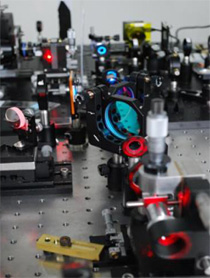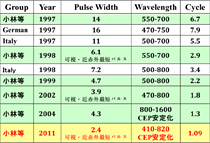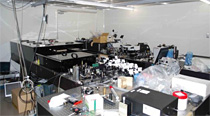Advanced Ultrafast Laser Research Center
Overview
The Advanced Ultrafast Laser Research Center is pursuing the following types of research with the support of the Japan Science and Technology Agency's CREST program.

- Fig. 1
- I The center is developing new methodologies for optical imaging and control (stimulus). More specifically, we are working on fluorescence-lifetime imaging microscopy, stimulated Raman imaging, and quantum noise limit super-resolution imaging using stimulated emission (fig. 1). We are also working to develop and expand the applications of these original imaging methods beyond passive observation equipment to active laboratory equipment that uses optical control to achieve precision and flexibility. We intend to develop devices for researching the process of neurological memory storage with other researchers. To that end, for decaging, we are working on developing caged compounds with low cytotoxicity, high photodissociation (decaging rates), and two-photon absorption cross-sectional areas.

- Table
- (opens nes window)Enlarged image (jpeg:102KB)

- Fig. 2
- II We developed a visual and near-infrared pulse laser (table) that has held the world record for shortest pulse for 13 years. For spectroscopy, we developed a deep ultraviolet and near-infrared ultrafast spectroscopy device that uses the world's fastest deep ultraviolet and ultraviolet pulses (fig. 2). Using this device, we will shed light on the mechanism of decaging and use the insight we acquire as a guide for new molecular synthesis.
In addition, we will analyze the mechanism of biological optical damage, which is a problem in extended laser microscope measurement and photic stimulation, at the molecular level and use our findings to determine how to avoid this damage. We will also analyze the initial molecular mechanism of ultraviolet-light carcinogenesis.
Purpose
The purpose of the Advanced Ultrafast Laser Research Center is to pursue optical cellular imaging using high-performance lasers, optical control, and the elucidation of optical damage processes through joint research with groups from the University of Tokyo Graduate School of Medicine and the Hiroshima University Graduate School of Science.
Period of Establishment
April 1, 2011, to March 31, 2016
(First period: April 1, 2010, to March 31, 2011)
Responsibilities
Activities
We are engaged in research whose goal is the development of super-resolution multicolor laser microscopes and the establishment of universal methods for elucidating the mechanisms of phenomena such as memory, carcinogenesis, immunity, and phototoxicity through the use of said microscopes for the multicolor microscopic observation and multicolor photic stimulation of the physiological processes of organisms and cells.
Expected Results
The results of the activities of the Advanced Ultrafast Laser Research Center are expected to extend beyond basic scientific research and make significant contributions to medical and social fields as we confront the aging of society.
